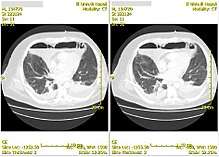Mediastinitis
| Mediastinitis | |
|---|---|
 | |
| Mediastinum | |
| Specialty |
Pulmonology |
Mediastinitis is inflammation of the tissues in the mid-chest, or mediastinum. It can be either acute or chronic.

Acute mediastinitis is usually bacterial and due to rupture of organs in the mediastinum. As the infection can progress rapidly, this is considered a serious condition. Chronic sclerosing (or fibrosing) mediastinitis, while potentially serious, is caused by a long-standing inflammation of the mediastinum, leading to growth of acellular collagen and fibrous tissue within the chest and around the central vessels and airways. It has a different cause, treatment, and prognosis than acute infectious mediastinitis.
Space infections: Pretracheal space – lies anterior to trachea. Pretracheal space infection leads to mediastinitis. Here, the fascia fuses with the pericardium and the parietal pleura, which explains the occurrence of empyema and pericardial effusion in mediastinitis.
Types
Acute
Before the development of modern cardiovascular surgery, cases of acute mediastinitis usually arose from either perforation of the esophagus or from contiguous spread of odontogenic or retropharyngeal infections. However, in modern practice, most cases of acute mediastinitis result from complications of cardiovascular or endoscopic surgical procedures.
Symptoms can mimic pneumonia.
Descending Necrotizing Mediastinitis
This is a particularly devastating polymicrobial infection involving the neck and below to the mediastinum. It is often caused by an untreated odontogenic infection spreading to the mediastinum. It has a particularly high death rate and can lead to septic shock. The mortality rate is around 10-40% and is usually caused by multi-organ failure. Also, broad spectrum antibiotic therapy and intensive care is required along with the surgery. The culprits are usually Gram-positive bacteria and anaerobes, though rarely, Gram-negative bacteria are also present. This severe form represents 20% of acute mediastinitis cases.[1]
Chronic
Chronic mediastinitis is usually a radiologic diagnosis manifested by diffuse fibrosis of the soft tissues of the mediastinum. This is sometimes the consequence of prior granulomatous disease, most commonly histoplasmosis. Other identifiable causes include tuberculosis, IgG4-related disease and radiation therapy. Fibrosing mediastinitis most frequently causes problems by constricting blood vessels or airways in the mediastinum. This may result in such complications as superior vena cava syndrome or pulmonary edema from compression of pulmonary veins. Fibrosing mediastinitis can be similar to fibrothorax.
Diagnosis
CT scan can be used.
Treatment
Treatment for descending necrotizing mediastinitis is emergency thoracotomy and mediastinal drainage, combined with broad spectrum IV antibiotics and intensive care monitoring.
Treatment for acute mediastinitis usually involves aggressive intravenous antibiotic therapy and hydration. If discrete fluid collections or grossly infected tissue have formed (such as abscesses), they may have to be surgically drained or debrided.
Treatment for chronic fibrosing mediastinitis is somewhat controversial, and may include steroids or surgical decompression of affected vessels.
References
- ↑ Pota, Vincenzo; Passavanti, Maria Beatrice; Sansone, Pasquale; Pace, Maria Caterina; Peluso, Filomena; Fiorelli, Alfonso; Aurilio, Caterina (2018-03-03). "Septic shock from descending necrotizing mediastinitis – combined treatment with IgM-enriched immunoglobulin preparation and direct polymyxin B hemoperfusion: a case report". Journal of Medical Case Reports. 12 (1): 55. doi:10.1186/s13256-018-1611-5. ISSN 1752-1947. PMC 5834850. PMID 29499757.
External links
| Classification | |
|---|---|
| External resources |
- Mediastinitis at the US National Library of Medicine Medical Subject Headings (MeSH)